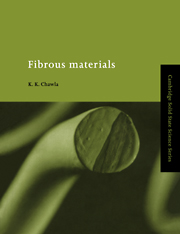Book contents
- Frontmatter
- Contents
- Preface
- Acknowledgments
- Chapter 1 Introduction
- Chapter 2 Fibers and fiber products
- Chapter 3 Natural polymeric fibers
- Chapter 4 Synthetic polymeric fibers
- Chapter 5 Metallic fibers
- Chapter 6 Ceramic fibers
- Chapter 7 Glass fibers
- Chapter 8 Carbon fibers
- Chapter 9 Experimental determination of fiber properties
- Chapter 10 Statistical treatment of fiber strength
- References
- Suggested further reading
- Appendix A Some important units and conversion factors
- Author index
- Subject index
Chapter 5 - Metallic fibers
Published online by Cambridge University Press: 13 October 2009
- Frontmatter
- Contents
- Preface
- Acknowledgments
- Chapter 1 Introduction
- Chapter 2 Fibers and fiber products
- Chapter 3 Natural polymeric fibers
- Chapter 4 Synthetic polymeric fibers
- Chapter 5 Metallic fibers
- Chapter 6 Ceramic fibers
- Chapter 7 Glass fibers
- Chapter 8 Carbon fibers
- Chapter 9 Experimental determination of fiber properties
- Chapter 10 Statistical treatment of fiber strength
- References
- Suggested further reading
- Appendix A Some important units and conversion factors
- Author index
- Subject index
Summary
Metals in bulk form are quite common materials and extensively used in engineering and other applications. Metals can provide an excellent combination of mechanical and physical properties at a very reasonable cost. One of the important attributes of metals is their ability to undergo plastic deformation. This allows the use of plastic deformation as a means to process them into a variety of simple and complex shapes and forms, from airplane fuselages to huge oil and gas pipelines to commonplace aluminum soda pop cans and foil for household use. What is less well appreciated, however, is the fact that metals in the form of fibers or wire have also been in use for a long time. Examples of the use of metallic filaments include: tungsten filaments for lamps, copper and aluminum wire for electrical applications, steel wire for tire reinforcement, cables for use in suspension bridges, niobium-based filamentary superconductors, and, of course, strings for various musical instruments such as violin, piano, etc. Highly ductile metals such as gold and silver can be drawn into extremely thin filaments. Filaments of such noble metals have long been used as threads in making Indian women's traditional dress called the saree.
Let us first review some of the important characteristics of metals, in particular, the ones that allow metals and their alloys to be drawn into fine filaments, and then describe the processing, structure, properties and applications of some important metallic filaments.
- Type
- Chapter
- Information
- Fibrous Materials , pp. 108 - 131Publisher: Cambridge University PressPrint publication year: 1998



